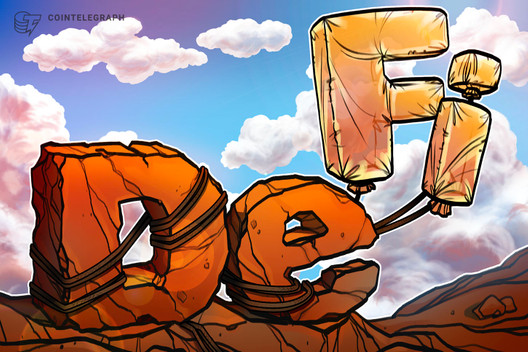Bitcoin can still drop to $20K but holding remains winning strategy, data shows
Unloading Bitcoin (BTC) spot positions when it starts crashing violently upon forming its all-time highs is a bad investment call, at least according to its historical price action.
The flagship cryptocurrency’s eleven-year lifetime has seen it undergoing many bullish and bearish cycles. The BTC/USD exchange rate typically rises parabolically. It later trims more than half of those gains down as profitable traders sell the top. But, at the same time, traders who buy bitcoin around its local top suffer longer periods of losses.
Got Bitcoin? Chances are you’re in profit
However, the overall historic price trajectory of Bitcoin remains skewed to the upside.
The cryptocurrency bottoms out after every bullish-to-bearish cycle and rebounds all over again to seek new all-time highs.
Its weekly timeframe chart shows the price forming consecutive higher highs separated by years — $500 in November 2015, $768 in June 2016, $2,998 in June 2017, $19,891 in December 2017, $41,986 in January 2021, and $64,899 in April 2021.

PlanB, the brain behind the widely-circulated Stock to Flow model, which predicts the Bitcoin price at $288,000 by 2024, referred to the cryptocurrency’s ability to return profits to patient investors in a tweet Friday morning. The pseudonymous analyst noted that not a single investor who held Bitcoin for more than four years ever suffered losses.
He cited the 200-weekly moving average curve as an invisible price floor that held the bitcoin market’s bullish bias higher during bearish corrections. The BTC/USD exchange rate tested the said support wave on its downside moves, only to rebound later to newer highs.

The statement appeared as the Bitcoin price showed signs of waning bullish momentum. The BTC/USD exchange rate topped near $65,000 in mid-April and corrected to as low as $30,000 on Coinbase almost a month later. As of May 28, the pair’s bid among traders was near $37,000.
Yes, if you buy bitcoin you buy to hold for a long term or forever. That is how the game is played. Now todays sellers are April buyers, that is unusual, that is weak hands.
— PlanB (@100trillionUSD) May 28, 2021
Meanwhile, PlanB’s long-term projects make Bitcoin appears like an asset that would keeping siphoning capital out of traditional markets. The analyst wrote earlier that he anticipates people to buy the cryptocurrency for its underlying scarcity — there can be only 21 million BTC in existence.
“Silver, gold, countries with [a] negative interest rate (Europe, Japan, US soon), countries with predatory governments (Venezuela, China, Iran, Turkey, etc.), billionaires and millionaires hedging against quantitative easing (QE), and institutional investors discovering the best performing asset of last 10 yrs” will influence people to seek safety in bitcoin, wrote PlanB in his 2019 paper, “Modeling Bitcoin Value with Scarcity,” as he envisioned a trillion-dollar market cap for the cryptocurrency.

The model prompts investors who bought Bitcoin at around $65,000 to hold the asset even if it takes more than four years for them to make their investments even. That is applicable only if Bitcoin continues to follow the stock-to-flow price model trajectory.
A stock-to-flow model is commonly used to measure commodity scarcity but may also be applied to #Bitcoin to generate actionable insights around $BTC’s supply. Learn more here: https://t.co/xZHtx86y0R pic.twitter.com/wF3c1JEB6H
— Grayscale (@Grayscale) September 2, 2020
A logarithmic curve chart based on the same bullish model anticipates the BTC/USD rates to fall to $20,000 or lower. The downside target appears after sketching a Fibonacci graph between the curve’s upper and lower bands. Its uppermost deviation sits near $111,590, while the lowest one is around $17,150.

The logarithmic curve’s historical significance in predicting price bottoms and tops makes it relevant enough for investors to realize their potential long and short targets.
Too unrealistic?
Despite their accuracy, the stock-to-flow model and its derivatives have attracted criticism for its unrealistic bullish portrayals of scarcer assets. Charlie Morris, co-founder, and CIO of crypto data firm ByteTree, told CoinTelegraph in November last year that bitcoin’s lower supply against higher demand does not guarantee higher prices.
People will still be able to sell bitcoin from existing active supply to meet the market’s demand, argued Morris.
Nico Cordeiro, the chief investment officer and fund manager at Strix Leviathan, also criticized the core assertion of scarcity-based Bitcoin pricing models, noting that no evidence suggests that supply dictates the U.S. dollar market valuation of monetary goods (gold, silver, or Bitcoin).
The past performance is not a guarantee of future results. But with Bitcoin gaining momentum among institutional circles in the wake of lower-yield investment safe-haven alternatives (government bonds, the U.S. dollar, etc.), it looks appealing to many to just “hodl” the token until further notice.
Fortune favors the HODL.
— Dan Hedl (@danheld) May 28, 2021
Disclaimer: The views and opinions expressed here are solely those of the author and do not necessarily reflect the views of Cointelegraph. Every investment and trading move involves risk, and you should conduct your own research when making a decision.









